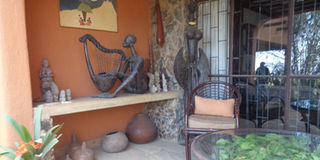A night at the African Heritage House

Front view of terrace of African Heritage House whose theme is inspired by Donovan’s travels across the continent in search of art. In Mali, he was awed by the ancient mud mosques of Timbuktu and the architecture of the palaces of the emirs and this inspired the construction of the African Heritage House. PHOTO | RUPI MANGAT
What you need to know:
- For starters, there’s Donovan who co-founded the African Heritage Pan African Gallery with Kenya’s second vice president, the late Joseph Murumbi and his wife Sheila, in the 1970s.
- The African Heritage House’s theme inspired by Donovan’s travels across the continent in search of art. In Mali, he was awed by the ancient mud mosques of Timbuktu and the architecture of the palaces of the emirs and this inspired the construction of the African Heritage House.
- He filled the house with all things African, collected from his travels, from the most beautiful textiles and cultures to African jewels.
It is often said that one way to travel the world without moving an inch is by reading books. I would add food and music to that list, I think to myself while chatting with Kire Godal of The African Channel, a cable TV channel in America and the UK showcasing programmes that celebrate Africans.
We are seated at the poolside of The African Heritage House, built by Alan Donovan in the 1990s on the plains overlooking the Nairobi National Park, and reputed to be the most photographed house in Africa. Godal is here with Minjiba Cookey, a popular food blogger from Nigeria, to shoot an episode of a TV series called Minjiba Entertains.
“We are shooting around Africa in the most beautiful homes and cooking for Africa’s most interesting people. The series will feature food, homes and glamorous lifestyles that nobody imagines exist in urban Africa,” he explains.
As we talk, a train chugs past on the railway that reached these plains in 1899. We are in good company. For starters, there’s Donovan who co-founded the African Heritage Pan African Gallery with Kenya’s second vice president, the late Joseph Murumbi and his wife Sheila, in the 1970s. They created Africa’s largest pan-African gallery; their collections can be seen at the Kenya National Archives in Nairobi, the Nairobi National Museum, and the Nairobi Gallery and of course at Donovan’s African Heritage House.
With us too is Martin Murimi, a musician who goes by the stage name Papillon, the French word for butterfly. The fortunes of Papillon who was once a street child changed when he met fellow musician Ayub Ogada of the Koth biro fame, while attending a musical workshop by Ogada at Amref. It was under Ogada’s wing that Papillon’s star rose, and tonight he is launching his new album.
MAGICAL MOOD
As the sun sinks behind Ngong Hills, Papillon takes to the stage with his stringed instrument – the anywal abel, meaning the caring parent in Acholi, a language from Uganda. He then invites Awalet Mehari, a young woman from Eritrea, on stage and the duo belt out tunes in Kiswahili and Tigrigna, the official language of Eritrea.
The symphony of different sounds of Africa sets a magical mood that goes down well with the platters of food coming out of Minjiba’s kitchen. Minjiba who has the body and looks of a runway model, is a self-confessed foodie who loves to mix and match different cuisines. Her new show on The Africa Channel is based on African fusion culinary treats.
“I’ve cooked traditional food tonight to go with the theme of the house,” she tells me, adding that she draws inspiration from the place she is at when she is cooking.
We savour her chicken in peanut sauce and beef stew served with hot and spicy Nigerian rice specialty, jollof rice. It is a magical night with a full moon shining over the national park. Later, climbing up the stairs to my rooftop room for the night, I marvel at the sight before my eyes: on one side is the wild bordering a capital city, while the other side is home to the unplanned mess that is Mlolongo.
Juxtaposed between the two worlds, the rooftop suite is inspired by Maasai culture, with spears and patterns painted by none other than Carol Beckwith, the famous photojournalist who documents the indigenous tribal cultures of Africa. She is working on her latest coffee table book on Africa’s vanishing cultures.
Carol’s artwork is in line with the African Heritage House’s theme inspired by Donovan’s travels across the continent in search of art. In Mali, he was awed by the ancient mud mosques of Timbuktu and the architecture of the palaces of the emirs and this inspired the construction of the African Heritage House. He filled the house with all things African, collected from his travels, from the most beautiful textiles and cultures to African jewels.
At first light the next morning, a white mist hangs over the national park, where a trio of giraffes nibbles on the dew-soaked leaves of acacias. I am at a good vantage point for wildlife photography, like Donovan, who in the 1990s photographed herds of wildebeest migrating from the Kitengela plains to the park in thousands. That migration is now a thing of the past because of a road that cuts right through the migratory path. Indeed the park and the house too have faced their fair share of threats.
Looking towards the iconic Ngong Hills, there’s a new onslaught – the standard gauge railway which almost put the African Heritage House under threat of demolition to pave way for the iron snake, but luckily, that never came to pass and the house still stands tall as a monument of African culture and heritage.




